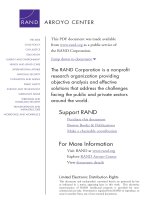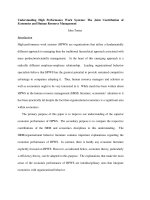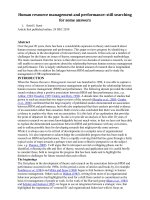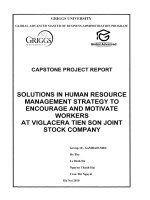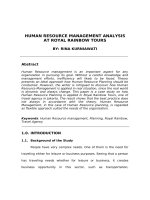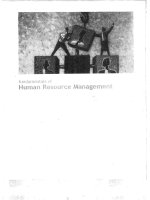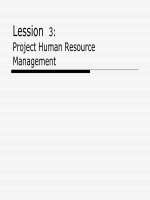Human resource management ethics and employment 4535
Bạn đang xem bản rút gọn của tài liệu. Xem và tải ngay bản đầy đủ của tài liệu tại đây (2.7 MB, 360 trang )
Human Resource Management: Ethics and Employment
This page intentionally left blank
Human Resource
Management:
Ethics and
Employment
Edited by
Ashly H. Pinnington
Rob Macklin
Tom Campbell
1
3
Great Clarendon Street, Oxford ox2 6
Oxford University Press is a department of the University of Oxford.
It furthers the University’s objective of excellence in research, scholarship,
and education by publishing worldwide in
Oxford New York
Auckland Cape Town Dar es Salaam Hong Kong Karachi
Kuala Lumpur Madrid Melbourne Mexico City Nairobi
New Delhi Shanghai Taipei Toronto
With offices in
Argentina Austria Brazil Chile Czech Republic France Greece
Guatemala Hungary Italy Japan Poland Portugal Singapore
South Korea Switzerland Thailand Turkey Ukraine Vietnam
Oxford is a registered trade mark of Oxford University Press
in the UK and in certain other countries
Published in the United States
by Oxford University Press Inc., New York
© Oxford University Press, 2007
The moral rights of the authors have been asserted
Database right Oxford University Press (maker)
First published 2007
All rights reserved. No part of this publication may be reproduced,
stored in a retrieval system, or transmitted, in any form or by any means,
without the prior permission in writing of Oxford University Press,
or as expressly permitted by law, or under terms agreed with the appropriate
reprographics rights organization. Enquiries concerning reproduction
outside the scope of the above should be sent to the Rights Department,
Oxford University Press, at the address above
You must not circulate this book in any other binding or cover
and you must impose the same condition on any acquirer
British Library Cataloguing in Publication Data
Data available
Library of Congress Cataloging in Publication Data
Human resource management: ethics and employment / edited by Ashly
Pinnington, Rob Macklin, Tom Campbell.
p. cm.
Includes bibliographical references and index.
1. Personnel management–Moral and ethical aspects. I. Pinnington,
Ashly. H. II. Macklin, Rob. III. Campbell, Tom, 1938–
HF5549.H8427 2007
2006026542
174′ .–dc22
Typeset by SPI Publisher Services, Pondicherry, India
Printed in Great Britain
on acid-free paper by Biddles Ltd., King’s Lynn, Norfolk
ISBN 978-0-19-920378-9 (hb)
ISBN 978-0-19-920379-6 (pb)
1 3 5 7 9 10 8 6 4 2
ACKNOWLEDGEMENTS
The editors would like to thank the Centre for Applied Philosophy and Public
Ethics (CAPPE), (Australian National University, Charles Sturt University,
University of Melbourne), an Australian Research Council Special Research
Centre, which sponsored the workshop on Ethics and Human Resource Management in Sydney, April 2004. Also, financial support was received from UQ
Business School, The University of Queensland, for some of the expenses in
developing this book. The workshop, from which it originated, was administered by Sheena Smith, then a Research Assistant at CAPPE, who also participated in the workshop. Our thanks to those who attended the workshop and
contributed papers, commentaries, and suggestions: David Ardagh (Charles
Sturt University), Lynne Bennington (La Trobe University), Breen Creighton
(Corrs Chambers Westgarth, Melbourne), Michelle Greenwood (Monash
University), David Guest (King’s College, London), Robin Kramar (Macquarie
University), Karen Legge (Warwick University), Gill Palmer (Monash University), Les Pickett (Australian Human Resource Institute), Chris Provis (University of South Australia), Sheena Smith (Australian National University),
Bernadine Van Gramberg (Victoria University of Technology), and Adrian
Walsh (University of New England). Thanks are also due to Karen Legge,
David Guest, and Tony Watson (University of Nottingham) for reviewing
some of the subsequent draft chapters for the book.
This page intentionally left blank
CO N T E N TS
ACKNOWLEDGEMENTS
LIST OF FIGURES
LIST OF TABLES
LIST OF CONTRIBUTORS
Introduction: ethical human resource management
Ashly Pinnington, Rob Macklin, and Tom Campbell
v
ix
x
xi
1
PART I SITUATING HUMAN RESOURCE MANAGEMENT
1 Socio-political theory and ethics in HRM
Gill Palmer
2 The ethics of HRM in dealing with individual employees without collective
representation
Karen Legge
3 HRM and performance: can partnership address the ethical dilemmas?
David E. Guest
4 Strategic management and human resources: the pursuit of productivity,
flexibility, and legitimacy
Peter Boxall and John Purcell
5 Ethical employment practices and the law
Breen Creighton
6 HRM and the ethics of commodified work in a market economy
Adrian J. Walsh
23
35
52
66
81
102
PART II ANALYSING HUMAN RESOURCE MANAGEMENT
7 Stakeholder theory and the ethics of HRM
Michelle Greenwood and Helen De Cieri
119
8 HR managers as ethics agents of the state
Lynne Bennington
137
9 The ethical basis for HRM professionalism and codes of conduct
David Ardagh
152
viii CONTENTS
10 Engineers of human souls, faceless technocrats, or merchants of
morality?: changing professional forms and identities in the face of the
neo-liberal challenge
Michael I. Reed
171
11 Ethical leadership in employee development
Ashly H. Pinnington and Serkan Bayraktaroglu
190
12 Ethics and work in emergencies: the UK fire service strike 2002–3
Tom Sorell
209
PART III PROGRESSING HUMAN RESOURCE MANAGEMENT
13 HRM, ethical irrationality, and the limits of ethical action
Tony J. Watson
14 Expanding ethical standards of HRM: necessary evils and the multiple
dimensions of impact
Joshua D. Margolis, Adam M. Grant, and Andrew L. Molinsky
223
237
15 Strategy, knowledge, appropriation, and ethics in HRM
Ken Kamoche
252
16 The morally decent HR manager
Rob Macklin
266
Conclusion
Tom Campbell, Ashly Pinnington, Rob Macklin, and Sheena Smith
BIBLIOGRAPHY
INDEX
282
292
328
LIST OF FIGURES
4.1 Three critical elements for the viability of the firm
4.2 Critical goals in HRM: a basic framework
68
73
7.1 The relationship between stake, rights, and responsibility
125
9.1 From human goods and needs to embodying social arrangements
155
LIST OF TABLES
9.1 Examples of ingredient good ends and needs-satisfiers of well-being
or eudaimonia
154
16.1 Sample of Heller’s norms and maxims adapted for the HR manager’s
context
274
LI S T OF C ON T RI B U T O RS
David Ardagh, Senior Lecturer in HRM, School of Commerce, Charles Sturt University, New South Wales, Australia.
Serkan Bayraktaroglu, Associate Professor of HRM, Department of Business Studies,
Sakarya University, Adapazari, Turkey.
Lynne Bennington, Professor and Head of School of Management, RMIT Business,
RMIT University, Melbourne, Victoria, Australia.
Peter Boxall, Professor of Human Resource Management, Department of Manage-
ment and Employment Relations, The University of Auckland Business School, Auckland, New Zealand.
Tom Campbell, Professorial Fellow, Program Manager, Business and Professional
Ethics, Centre for Applied Philosophy and Public Ethics, Charles Sturt University,
Canberra, Australian Capital Territory, Australia.
Breen Creighton, Professorial Fellow, Faculty of Law, University of Melbourne, Victo-
ria, Australia.
Helen De Cieri, Professor and Director of the Australian Centre for Research in
Employment and Work (ACREW), Department of Management, Monash University,
Melbourne, Victoria, Australia.
Adam M. Grant, Doctoral Candidate in Organizational Psychology, University of
Michigan, Ann Arbor, Michigan, USA.
Michelle Greenwood, Assistant Lecturer, Department of Management, Monash Uni-
versity, Melbourne, Victoria, Australia.
David E. Guest, Professor of Organizational Psychology and Human Resource Man-
agement, Department of Management, King’s College, London, UK.
Ken Kamoche, Associate Professor, Department of Management, City University of
Hong Kong, Hong Kong.
Karen Legge, Professor of Organisational Behaviour, Industrial Relations and Organ-
isational Behaviour Group, Warwick Business School, University of Warwick, Coventry, UK.
Rob Macklin, Senior Lecturer, School of Business, Charles Sturt University, Albury,
New South Wales, Australia.
Joshua D. Margolis, Associate Professor, Harvard Business School, Boston, Massa-
chusetts, USA.
xii LIST OF CONTRIBUTORS
Andrew L. Molinsky, Assistant Professor of Organizational Behavior, Brandeis International Business School, Waltham, Massachusetts, USA.
Gill Palmer, Professor and Dean of the Faculty of Business and Economics, Monash
University, Melbourne, Victoria, Australia.
Ashly H. Pinnington, Professor of Human Resource Management, Aberdeen Business
School, The Robert Gordon University, Aberdeen, Scotland, UK.
John Purcell, Professor of Human Resource Management, Director of the Work and
Employment Research Centre, School of Management, University of Bath, Bath, UK.
Michael I. Reed, Professor of Organisational Analysis (Human Resource Management
Section) and Associate Dean (Research), Cardiff Business School, Cardiff University,
Wales, UK.
Sheena Smith, Postgraduate Research Student, Department of Philosophy, Australian
National University, Canberra, ACT 0200, Australia.
Tom Sorell, John Ferguson Professor of Global Ethics, University of Birmingham,
Birmingham, UK.
Adrian Walsh, Senior Lecturer, School of Social Science, University of New England,
Armidale, New South Wales, and Research Associate, Centre for Applied Philosophy
and Public Ethics, University of Melbourne, Melbourne, Victoria, Australia.
Tony J. Watson, Professor of Organisational Behaviour, Nottingham University Business School, University of Nottingham, Nottingham, UK.
Introduction: ethical
human resource
management∗
Ashly Pinnington, Rob Macklin, and Tom Campbell
It is a curious fact that the current surge of interest in business ethics has
largely bypassed the theory and the practice of human resource management
(HRM). While business as a whole is presenting itself more and more in terms
of social responsibility, and employees are routinely accepted as crucial stakeholders in most business organizations, HRM practice continues to affirm its
significance for corporate profitability and prefers to distance itself from its
traditional welfare image. It is, therefore, timely to revisit the subject of ethics
in employment with respect to HRM, and to do so in a way that brings out
the complexity of articulating a conception of ethical HRM that goes beyond
a shaky affirmation that ‘good ethics is always good for business’.
The contemporary context
Business ethics as a field of study and as an issue with currency in the broader
community has grown considerably in recent years. This interest has been
increased, it can be suggested, by a series of corporate scandals that have stimulated a small explosion in academic publications on corporate governance
(Zoffer and Fram 2005) and led to a greater concern to include ethics courses
in business school curricula (Crane 2004; Elliott 2004; Evans and Marcal 2005;
Koehn 2005).
At the regulatory level many government bodies have or are establishing
mechanisms to facilitate good business practices. For example, in the USA in
July 2002 the Sarbanes-Oxley Act was passed, while in Australia the Federal
government has adopted an approach that focuses on providing principles
that help to educate people in organizations about good corporate governance (Williamson-Noble and Haynes 2003). In the UK, the government
∗ The editors acknowledge the significant contribution made by Sheena Smith to this introduction
and thank her for all her work on the project as a whole.
2 INTRODUCTION
encourages adoption and reporting on corporate social responsibility (CSR)
through guidance on best practice, regulation, and fiscal incentives (DTI
2004). In addition, within the corporate sector it would now appear that there
is also a growing interest in the development of corporate codes of conduct
or ethics (Florini 2003). In this respect the Illinois Institute of Technology,
Center for the Study of Ethics in the Professions, ‘Codes of Ethics Online’
provides a large and growing collection of codes drawn from a wide variety
of industries including communication, IT, engineering, finance, and real
estate.
Given all of these initiatives in business ethics and CSR, one might expect a
similar growth of interest in ethics and HRM. After all an extremely important
component of making business more ethical is to take seriously the ethical
aspects of managing people (Winstanley and Woodall 2000a). A review of the
literature does indeed reveal a modest growth of interest in the subject. Over
the last decade there have been a number of books, edited collections (Parker
1988a; Winstanley and Woodall 2000b; Woodall and Winstanley 2001), and
articles published on ethics in academic journals (e.g. Personnel Review Vol 25,
No 6 1996) and elsewhere (e.g. Schumann 2001; Shultz and Brender-Ilan 2004;
Weaver 2001). Nevertheless, it has not really kept pace with developments in
the broader field of business ethics.
Many business ethics textbooks contain chapters on the ethical issues that
may arise in the employment relationship, including the ethics of discrimination, and employees’ rights and duties (e.g. DesJardins and McCall 2005;
Jennings 2006; Velasquez 2006). However, often they focus on individual practices rather than on the ethics of HRM policies and practices in organizations
or on the roles of human resource (HR) practitioners. There is, therefore,
a need to address these gaps in the business ethics literature to foster more
debate on ethics amongst HR practitioners, commentators, and academics.
Bringing ethical awareness into the core of HRM is all the more important
given the trend in Western societies towards decline of trade unionism and
the emergence of more individualist approaches to employment (Deery and
Mitchell 2000; Peetz 2004; and Legge Chapter 2 in this volume). The turn
towards individualism in employment has arguably placed the morality of
HRM increasingly in the hands of managers and HR managers in particular.
In the past, the employment relations practices of employers were more open
to scrutiny by other powerful parties such as trade unions and industrial
tribunals. These collectivist systems of industrial relations (IR) helped to
maintain some checks on employers who sought to exploit their employees.
Moreover, collective agreements and especially those with clauses on the conduct of the employment relationship, acted as a guide for many employers and
employees as to what constituted acceptable behaviour.
The decline of collectivist arrangements has left many employees potentially
more vulnerable to opportunistic and unethical behaviour (Watson et al.
INTRODUCTION
3
2003). Except in occupations where market conditions overwhelmingly favour
the employee, employers are in an increasingly powerful position to govern
and dominate the employment relationship (Smith 1997). This throws more
into question the morality of contemporary HRM and increases the significance of engaging in moral evaluation of the behaviour of directors, managers,
and HR practitioners. It is within this broad context that this book seeks to
highlight the ethical and moral dimensions of HRM.
There are many different ways of defining HRM (e.g. for a more detailed
discussion Legge 1995; Storey 2001). ‘HRM’ may be seen as one amongst many
possible labels, such as ‘personnel management’, that denote the generic practices pertaining to certain functions such as recruitment, selection, training,
remuneration, promotion, and separation. Alternatively, HRM may be seen
as identifying a particular approach to such functions of employment rather
than as a generic name for the management of employees within a public or
private service organization. Its common conception of ‘people management’
is one that focuses on the creation and sustainment of a committed, loyal,
and capable workforce required to deliver significant competitive benefits for
the organization (Legge 1995: 64–7). According to Storey (1995), HRM in
this more specific sense involves line and top management in pursuing the
belief that a committed and capable workforce will give the organization a
competitive advantage. It offers a theory of HR decisions as being of strategic
and commercial importance and promotes development of an organizational
culture of consensus, commitment, and flexibility. Within this specific conception of HRM, Storey helpfully distinguishes a ‘soft’ and a ‘hard’ version of
HRM. Emphasis on culture is associated with soft HRM (although even soft
HRM sees itself as promoting long-term profitability) in which employees are
regarded as a source of creative energy and participants in workplace decisionmaking, while an emphasis on alignment of HRM with the strategy and structure is more characteristic of a hard version of HRM that is more explicitly
focused on organizational rationality, control, and profitability (Pinnington
and Lafferty 2003).
It is often argued that the stereotypes of hard and soft HRM are both
inimical to ethics because they attend to the profit motive without giving
enough consideration to other morally relevant concerns such as social justice
and human development. It remains a matter for empirical research whether
the hard and soft stereotypes of HRM in some circumstances offer the most
effective means of maximizing corporate profitability. Even so, it is an important ethical issue whether the moral issues outweigh pragmatic concerns for
organizational profitability. Clearly, these clusters of empirical, normative, and
substantive questions cannot be resolved solely by terminological definition or
even through a singular mode of conceptual analysis (Graham 2004). Therefore, we determine in this book to assume a generic and open-ended definition
of HRM as denoting a bundle of functions relating to the management of
4 INTRODUCTION
employees, thus encouraging a certain open-mindedness on the ethical and
moral questions that arise. Most of the contributors to this book work with
such a generic conception of HRM. Nevertheless it is important to keep in
mind that the context of this work is one in which the more instrumental connotations of HRM as a contemporary form of strategic employee
management for enhancing corporate profitability is frequently assumed to
be the dominant paradigm.
Business ethics and HRM
‘Business ethics’ we understand in this book as referring to the moral evaluation of the goals, policies, practices, and decisions taken within business
organizations as they impact on human well-being, fairness, justice, humanity,
and decency. Here, the term ‘ethics’ is synonymous with ‘morality’ which
are in general equivalent terms, the former stemming from Greek and the
latter from Latin roots. Both refer to that aspect of human experience which
involves making what purport to be impartial judgements as to the ultimate
rightness and wrongness of conduct and the values to which priority ought to
be given in personal, social, and political decision-making (Maclagan 1998).
In so far as the usage of the two terms does diverge, ethics is more commonly deployed to refer to what we call ‘role performance’ which applies
to the conduct of persons fulfilling a particular social role, such as parent,
or employer, while morality has a more general connotation, ranging from
personal behaviour to the assessment of laws and social organizations (see,
e.g. Baier 1958; Beauchamp and Bowie 2004; Solomon 1997).
Often business ethics is presented in terms of the decisions facing individuals as board members, managers, or employees and the dilemmas (i.e. choices
between competing moral considerations), or temptations (as in conflicts of
interest) facing them. However, these individual choices have to be seen in the
context of the roles that people are expected to play within a specific organization operating in a particular type of political, economic, and social system.
This means that business ethics has to consider the moral critique of business
and management practice as a whole and not just address the behaviour of
individual managers and others. It is individuals who must ultimately make
moral choices, either on their own or collectively, but identifying what choices
exist and decisions they ought to make requires analysis of the morality of the
existing and potential system and its constituent roles (Bowie and Werhane
2005: 1–20; MacIntyre 1981, 1988).
This broad approach to business ethics does not entail that ethics in business is something that comes into business ready made from the wider world
as an external imposition of standards that have been developed and refined
INTRODUCTION
5
elsewhere. Rather, business has its own ethics, a specific ethics that draws
on general moral principles but refines and develops these in the light of
its own particular goals, requirements, institutions, and objectives. Consequently, business ethics is not a compartmentalized add-on to business, but
a dimension of business and specifically one that is inescapably present in all
management decisions.
In making this point we nevertheless recognize that in recent times some
writers have sought to critique the foundations of ethics. Writers commonly
associated with postmodernist ways of thinking have been strongly critical of
the assumption that our actions and pursuit of an ethical existence can be
justified by returning to the essence of the matter or by explaining exemplars
and relating master narratives (Lyotard 1984). Many postmodernists eschew
such descriptions purporting to demonstrate how the world and societies
operate, and caution against giving general prescriptions on how it should
operate (Bauman 1989, 1994, 1995).
Bauman’s questioning (1993) of attempts to ground ethics in foundations or essences has been especially influential on some of the recent academic debates within business and management and organizational theory
(Jones, Parker, and Bos 2005; Parker 1998a, 1998b). He draws attention to
the immoralities apparent within modernist and totalitarian government rule
suggesting that they are nurtured by a bureaucratization of the ethical. Many
of the technical procedures and rule-following behaviours characteristic of
modern societies, he argues, often promote an emotional distance and lack of
respect for others, and particularly for those who are relatively more disadvantaged (Munro 1998). To avoid a descent into nihilism, Bauman proposes that
the way out of the dilemma is through encouraging development in others of
what he calls the ‘moral impulse’. His post-foundationalist approach to ethics
endeavours to overcome some of the inevitable confusion created by empirical
relativism and moral uncertainty by inviting individuals to transcend their
egoistic moral understandings of the social self and consequently, act more
caringly and responsibly towards others (Benhabib 1992; Legge 1998a, 1998b;
Letiche 1998; Willmott 1998).
In general, the chapters within this book are not ‘against ethics’ as such
although all are to varying degrees critical of ethical codes or moral recipes
that oversimplify the realities of making moral decisions. All of the contributors to this book are interested in understanding the many duties, responsibilities, and issues of care and concern for others that arise within employment
and in HRM. This means that in some cases norms, principles, and codes are
raised and discussed, but we suggest this is largely done with an awareness of
the deleterious effect that creating rules can have on the autonomy of others.
The chapters address both the more recent and other long-standing debates
on ethics and moral problems through adopting a wide variety of perspectives
on business, ethics, HRM, and employment. The summaries in the remainder
6 INTRODUCTION
of this Introduction, bring out the common thread of a concern for the role
of HRM in the structure and dynamics of both (business) utility and moral
decency in modern employment relations.
The chapter contents
Part I (Situating Human Resource Management) deals with the economic,
political, and legal contexts within which ethical issues in contemporary HRM
arise, including employment relations, theories of management, economic
philosophy, strategic management, innovation, and the productive use of
physical and human resources. Part II (Analysing Human Resource Management) looks at the emerging practices and institutional settings of HRM in
ways that bring to the fore their ethical dimensions. Here, the prospect of
HRM as an emerging profession with distinctive ethical commitments and
responsibilities for workplace business ethics, justice, and human rights is
considered critically in the light of existing and potential cultural, legal, and
economic frameworks. Part III (Progressing Human Resource Management)
explores the avenues for reforming HRM in the light of different managerial
futures, moral philosophies, and institutional arrangements.
All of the six chapters in Part I concentrate on the contemporary macroenvironment, albeit from very different perspectives.
Chapter 1 by Gill Palmer (Socio-political theory and ethics in HRM) seeks
to contextualize the comparatively new discipline of specific HRM in older
debates on the management of people at work (generic HRM). Generic HRM
is related to socio-political frameworks that have been used to understand the
nature of authority, government, and consent within society. Three types of
political theory are discussed: unitarist, radical, and pluralist. Palmer charts
the historical changes of focus and content of the debates ranging from unitary
theories with their use of organic analogies and emphasis upon the managerial
prerogative to radical theories seeking to end the exploitation they believe
to be inherent in capitalist employment relations. In more recent times, the
debates have tended to focus less on arbitrating between the oppositions of
unitary and radical theories and more upon how to deal with an inevitable
plurality of interests at work. Three major theoretical approaches throughout the twentieth century are compared and contrasted: liberal-individual
pluralism, liberal-collective pluralism, and coordinated, neo-corporatist
pluralism.
Liberalism, it is argued, remains the basis of our modern economic and
political democratic thought, although it has been suffused by concepts
from corporatism emphasizing the roles of the nation state for regulating
INTRODUCTION
7
or influencing the economy and labour markets. Using illustrations from
central Europe and China, Palmer notes that whereas there are common and
ingrained social and political values evident in many Western economies they
have not been sufficiently influential to erase substantial differences occurring
across the globe in the normative organization of work.
Chapter 2 by Karen Legge (The ethics of HRM in dealing with individual employees without collective representation) examines the slow death of
collectivism and the distinctions between the respective ethics of individualism and collectivism. In the context of autonomy at work, the privileges and
benefits pertaining to knowledge workers are contrasted with the much tighter
constraints and more limited benefits faced by routine service sector workers.
Legge asks what would constitute the most ethical employment relations system for employees without collective representation. Her conclusion is that
collective representation is essential for establishing and preserving a just and
reasonable level of equality of relationship between employer and employee.
Legge considers what forms such representation might take and proposes
that the most realistic role for trade unions will be to work within the pressures
and restrictions of individualistic, consumer-oriented culture. Essentially this
requires playing the instrumental collectivist role whereby unions are first and
foremost a means of redressing individual employees’ vulnerabilities when
dealing with employers. This position is arrived at through the examination of
recent developments in HRM and employee relations applying Isaiah Berlin’s
‘positive’ and ‘negative’ conceptions of liberty as the means of analysis. The
overall picture presented is one in which groups of employees without collective representation are not enjoying the good life at work as a result of explicit
or implicit HRM policies. Furthermore, there is little evidence that what is
ethically desirable for employees is emerging out of the contemporary roles
and responsibilities of HRM.
Chapter 3 by David Guest (HRM and performance: can partnership address
the ethical dilemmas?) reflects on the idea that HRM has been built on two
main propositions that: (a) people are a source of competitive advantage,
and (b) effective management of HR should lead to superior performance. In
this context, Guest addresses four issues in HRM which raise potential ethical
questions. The first is that while HRM claims to be primarily concerned with
the management of people, in practice it largely ignores them, and second, that
HRM is a subtle way of exploiting people. The third is the research on HRM
and performance is far more provisional than some of its proponents and
followers claim, and the fourth is the challenges and problems that are created
when attempting to apply an integrated HR system in these circumstances.
Guest draws the reader’s attention to the significance of research work
on HRM and performance conducted during the 1990s which found strong
evidence for a relationship between the two. However, he criticizes the discipline both in terms of research endeavour and as a management practice for
8 INTRODUCTION
sometimes paying no more than lip service to the tenet that ‘people are
our most important asset’. Evidence from research studies of recent implementations of HR practices designed to achieve a ‘high-commitment’ workforce suggests that first most people prefer soft HRM to the other available
approaches and second, moral safeguards, nevertheless, need to be established.
These would include HR systems focused on employee well-being, such as
in establishing and maintaining channels for independent employee voice.
Ethical problems, he argues, also arise from institutions making inflated pronouncements on the extent of causal linkage existing between implementing HR practices and achieving improved performance. This is a particular
consideration for governments, consultancies, and professional bodies where
the temptation to exaggerate the efficacy of HR practices can be greater than
within the academic research context. Since the early 1990s there has been
growing talk of partnerships between employers and trade unions, but the
evidence is that they have not really taken root, in part due to mistrust remaining on both sides. Guest concludes that partnership still has the potential to
address a number of ethical concerns in HRM practice, but cautions his reader
to be sanguine about the limited adoption and efficacy of HRM to date.
Chapter 4 by Peter Boxall and John Purcell (Strategic management and
human resources: the pursuit of productivity, flexibility, and legitimacy) is
concerned with the nature of strategic HRM (SHRM), its role and influence
on business performance and the ethical issues involved in this relationship. It
commences by defining strategy and reviewing common strategic problems
facing firms, inquiring how HRM contributes to a firm’s viability and the
achievement of competitive advantage. The central ethical question addressed
is the way that managers pursue their goals for labour productivity and organizational flexibility whilst also meeting the requirements for social legitimacy.
These goals are often in tension.
Boxall and Purcell’s chapter adopts a broad view of business performance
and presents an innovative conceptual framework for a socially responsible
and sustainable model of generic HRM. While many business analysts accept
the goal domains of labour productivity and organizational flexibility, the
authors argue that the pursuit of legitimacy is also vital because firms are
always ‘embedded in structures of social relations’ (Granovetter 1985). In
summary, legitimacy is a contested area wherein employers and employees
must observe the ethicality of their actions in the eyes of others.
Chapter 5 by Breen Creighton (Ethical employment practices and the law)
commences by noting that ideas about what constitutes ethical behaviour tend
to reflect the moral values of society at a particular point in time. This chapter
focuses specifically on the extent to which the law can be seen to mandate
and/or facilitate ethical employment practices in Australia in the early-twentyfirst century. On the one hand, current legislative provision retains a distinctive ‘IR’ character. On the other hand, as in other countries such as the UK,
INTRODUCTION
9
New Zealand, and the USA, it has also clearly been influenced by HRM and
ER practices and assumptions.
Ethical behaviour in this context comprises four key elements: respect for
individual employees’ dignity and personal integrity, protecting their physical and mental integrity, providing access to ‘decent work’, and moderating
the detrimental effects of power imbalances between buyers and sellers of
labour. The historical role and contribution of the law as a facilitator of ethical
behaviour is examined, first in the law of master and servant and family law
and then in modern statute law. Creighton concludes that for over 200 years
there has been legislative recognition that it would be unacceptable from an
ethical perspective to leave the well-being of working people entirely at the
mercy of market forces.
This is reflected in the fact that after federation in 1901, a process of
compulsory conciliation and arbitration became established and remained in
place until a fundamental reorientation of the system occurred in the early
1990s. The recent changes are characterized by a move away from centralized
regulation of terms and conditions by awards of tribunals in favour of direct
negotiation at the level of the enterprise. Since 1996 there has been a further
shift in favour of individualization and ‘de-collectivization’ of work relations.
This process was given further impetus by major legislative changes that were
adopted in late 2005. Despite these shifts in emphasis, the law continues to
make some attempt to encourage ethical employment practices. Reflecting on
the achievement of the Australian system in this context Creighton concludes:
‘The collectivist character of the provisions relating to awards and agreements
may strike a discordant note for some observers, and for some participants in
the system. But the contribution is none the less real for that.’
Chapter 6 by Adrian Walsh (HRM and the ethics of commodified work in a
market economy) examines HRM from the perspectives of political and economic philosophy. It argues that work in a market economy can be exploitative
and lead to commodification but not to such an extent that renders an ethical HRM impossible. Walsh argues that the market presents employers with
certain ‘moral hazards’ especially in areas where employers and employees
do not have shared interests. The chapter focuses on three areas of concern:
attitudes towards wealth, economic exploitation, and the content of work. Its
central assumption is that regarding employees solely and ultimately as mere
commodities is unethical. In essence, market institutions such as price corrode
our capacity to value goods intrinsically.
Contemporary HRM is commonly declared to have more of a focus on
the profit motive than had previous forms of personnel management, but
ethical problems arise whenever the profit motive leads to exploitative wage–
labour contracts. Moreover, market economies often place systematic pressure
on participants to increase the level of exploitation of available labour, for
example, by aggressively reducing labour costs to meet falling prices for goods
10 INTRODUCTION
and services, although this is not to say that pursuing profit is inherently
unethical. Walsh distinguishes ‘lucrepathic action’ (profit-making is an allencompassing motive) from ‘accumulative action’ (profit-making is moderated by moral constraints) and ‘stipendiary action’ (profit-making is not a
central goal). He reasons that the responsibility of employers is to desist from
acting lucrepathically, and following Amartya Sen’s capabilities approach,
advises that both employers and employees should regard work as more than
just a way of gaining an income. Work, as Sen and others have argued, ought
to function primarily as a meaningful context for the further development of
our capabilities.
The next six chapters in Part II (Analysing HRM) concentrate on the
contemporary organization but still situated within its broader environment, particularly ethical theories and perspectives on HRM such as stakeholder theory, moral advocacy, moral decency, cultural leadership, appropriation, and contemporary collectivist and individualist moralities. All of
the chapters within this section concentrate on difficult questions of ethics
facing employers, managers, and people working specifically in the HR
function.
Chapter 7 by Michelle Greenwood and Helen De Cieri (Stakeholder theory
and the ethics of HRM) analyses the potential of stakeholder theory as an
approach to formulating and enacting ethical HRM. The authors note that
stakeholder theory focuses on the relationship between organizations and
constituent groups, which they suggest offers a fruitful and alternative way of
conceptualizing ethics in contrast to existing debates on rights and procedural
justice in employment relations. The stakeholder concept narrowly defined
refers to groups that the organization depends on, typically shareowners,
employees, customers, lenders, and society (Freeman 1984). A claimant definition of stakeholders however is preferred by the authors whereby: ‘A stakeholder is an individual or group that has a moral claim, by virtue of a sacrifice
or contribution and therefore is owed a moral duty by the organization.’
Greenwood and De Cieri note that the ethical debates in HRM adopt either
a macro-level environmental analysis or a micro-level focus on individual
practices. At the macro end of the scale, the central subject for ethical scrutiny
is HRM as a system. This analysis corresponds to some extent with the SHRM
literature’s focus on multiple practices at the organizational level of analysis
(Wright and Boswell 2002). Macro-level research has the potential to reach
beyond the limitations of these methodologies by conceptualizing the totality
of HRM within the contexts of both corporate and societal levels of analysis. Greenwood and De Cieri review the contribution of stakeholder theory
in managerial discourses and the moral duty of management to act in the
interests of stakeholders and engage them in decision-making. Stakeholder
engagement places specific moral demands on managers through understanding employees as moral claimant stakeholders rather than simply ‘strategic
INTRODUCTION
11
stakeholders’. The authors observe that the economic costs of this scenario
can be especially high and may not always be justified, but other approaches
present opportunity for moral hazard and expose the vulnerability of employees to unethical treatment.
Chapter 8 by Lynne Bennington (HR managers as ethics agents of the
state) focuses on the ethical duty of legal compliance in equal employment
opportunity (EEO) and affirmative action (AA). It observes that the amount
of common and statute law has increased over the last thirty years imposing
greater responsibilities and duties on employers and their respective HRM
teams. The situation is an especially challenging one for HR managers when,
at least in the USA, they have been excluded from legislated whistle-blowing
protection and are only advocates of EEO within strict boundaries. Bennington argues that the state can expect little improvement in employer conduct
in areas such as EEO and AA until better protection is offered to employees
working within HRM aiming to ensure legal compliance.
With the onset of private sector styles of operation in the new public management, the public sector has lost its premier position as a role model for
sector adherence to EEO legislation. Consequently, controls over consistency,
fairness, and equity in personnel systems have become weakened. Employers adopt different perspectives ranging from hostility to support; external
recruitment consultants do not always adhere to EEO laws; and applicants
for jobs more often than not are in a weak position to identify or counteract
recruitment and selection practices that are unfairly discriminating. This has
tipped the balance towards a corporatist focus rather than, for example, an
employee-centred approach. A broad survey of legal protection of HRM managers who seek to go down this path demonstrates little effective protection.
Chapter 9 by David Ardagh (The ethical basis for HRM professionalism
and codes of conduct) searches for an invigorated profession of HRM by
investigating the potential of combining Aristotelian ideas of virtue ethics with
current criteria for assessment of what constitutes an exemplary profession.
His purpose is to empower practitioners to uphold high ethical standards.
Members of an HRM profession, he argues, should be supported to the point
where they can be relied on to espouse strong moral values, possess integrity,
and demonstrate independence in the exercise of their professional responsibilities and duties.
Ardagh contends that the Aristotelian idea of basing ethics on the development of capacities and perfection through virtue continues to hold relevance
for people, including employees working in HRM. In this neo-Aristotelian
system of ethics, the ideal object is ‘well-being’, abstractly understood as living
and acting well—known as eudaimonia. Influenced by the neo-Aristotelian
conceptualization of ethics, Ardagh recommends professionalization of HRM
and granting it greater authority as steps towards forming a much stronger
corporate conscience. He discusses how a number of criteria for forming a
12 INTRODUCTION
profession are missing in contemporary HRM systems—mandatory training
process, self-licensing, exams/induction, monopoly control, a tradition of
practice, and an enforced code of ethics. In addition, there are a number
of other criteria which he outlines as necessary and desirable for creating
a rigorous HRM profession. These include a code of conduct specifying
altruistic duty to clients, a de-registering mechanism, mandatory continuing
education, fiduciary relationships, professional-like detachment, strong public
ethics relevance, the right to advocate within an institutionalized system, and
the expectation of potential clashes with as organizational policy.
Inevitably, such changes would require substantial change in social policy
and corporate law reform. Ardagh argues in favour of a social concessional
model of corporations and for increased corporate moral responsibility. To
educate HR professionals, he recommends an interdisciplinary social policy
and social economics curriculum, adopting an overt critical, justice-oriented
approach.
Chapter 10 by Michael Reed (Engineers of human souls, faceless technocrats or merchants of morality?) examines changing professional forms and
identities in Western countries following from more than ten years of neoliberal government policies. It seeks to draw attention to three possible ethical futures for professionalism. The first phrase (engineers of human souls)
refers to a simplistic vision of return to the traditional professional values of
autonomy and ethical service. The second phrase (faceless technocrats) evokes
a managerialist and technological determinist future for the professionexhorting professionals to become thoroughly reconciled to serving the goals
of corporate capital, whereas the third (merchants of morality) is intended to
indicate an emergent role for the professions and professionals as purveyors
of trust during an age of public suspicion and corporate uncertainty.
Reed reflects on the fact that professionalization of the expert division
of labour was the dominant strategy for occupational closure over much of
the previous century. During the last three decades, however, a number of
crises have occurred within the Western traditional liberal professions and the
political economies of welfare states resulting in a somewhat more fragmented
collection of competing occupations.
Under such circumstances, he asks, ‘How is institutionalized trust, as the
structural cornerstone and cultural lodestone of professionalism, to be generated and sustained in an economic, social, and political environment dominated by unregulated market competition, unrestrained consumerism, and
rampant individualism?’ His answer is a somewhat pessimistic one since he
sees little prospect of reestablishing the autonomy of professions, of their
public acceptance of skilled social engineers. Nevertheless, he sees a continuing
role for professions in providing theories, programmes, and control technologies operating simultaneously at the macro level of institutional governance
and at the micro-level of individual choice and subjectivity. In summary,

